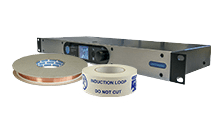What technologies could possibly replace them and when?
In an attempt to answer these questions the International Hearing Access Committee*, representing a number of leading hearing organisations, stated in a recent article...
"...that it is reasonable to believe that TC [telecoils], HL [hearing loops] /ALS [assistive listening solutions] usage will continue for the next 10-15 years and beyond."
source: Hearing Loops and Telecoils..., International Hearing Access Committee, June 2019
The question arose due to the proliferation of digital audio streaming systems installed in public access areas, places of worship and entertainment / recreation venues and how best to connect hearing aid users with those systems.
The European Hearing Instrument Manufacturers Association (EHIMA) have spent a number of years trying to set a Standard profile for hearing aid Bluetooth connectivity, the most likely replacement technology, however this process has yet to produce a suitable solution.
The key difficulties associated with replacing hearing / induction loops is that the telecoil is hard to replace. Telecoils offer:
- passive – zero energy use
- very low cost
- non-proprietary, open standard
- easiest access, just turn on or off
- no latency, AKA delay issues
- large install base of telecoil receivers already
To replace loops:
- All the stakeholders have to agree on something that could provide universal access. This would require technology that is open, non proprietary, global, simple. It would also have to work with low power consumption, sufficient range, low latency and low cost. This is not so easy, with so many stakeholders with vested interests.
- Once something is agreed and standards are published, then devices need to be designed with the new technology. For hearing aids, that most probably means a trickle down of technology from the premium instruments to the mass market devices over a number of years.
- Then there is a period of time for these new devices to enter the market, and get a sensible proportion of the hearing aid user base. Again several years at least.
- Then there will be a long period where the existing technology – loops – will remain very relevant because of the high volume of installed systems and a majority of hearing devices not having the new connectivity. There is likely to be a bridge period where installed systems are either backward compatible (radio receivers with neckloops) or forward compatible (loop receiver to radio convertor).
In the final part of their statement the IHAC set realistic expectations:
"HA/CI [Hearing aid / cochlear implant] users require continued quality hearing access in public places which is currently, and in the foreseeable future, provided by TC [telecoils] and HL/ALS [hearing loop / assistive listening solutions]. The rights of HA/CI users to access must be continued and maintained during this period of technological change and shall not be compromised by the promise and overly optimistic expectations of a future technology development."
*The International Hearing Access Committee (IHAC), includes representatives from:
- International Federation of Hard of Hearing People
- Deutschen Schwerhörigenbundes e.V. (DSB)
- International Hearing Loop Manufacturers Association (IHLMA)
- European Hearing Instrument Manufacturers Association (EHIMA)
- European Federation of Hard of Hearing People (EFHOH)
- Hearing Loss Association of America (HLAA)
If you have any questions regarding the technologies available for your assistive listening needs please contact our friendly and knowledgeable team on +44 (0) 1636 610062 or email support@ampetronic.com.


